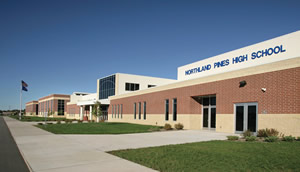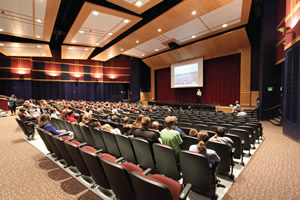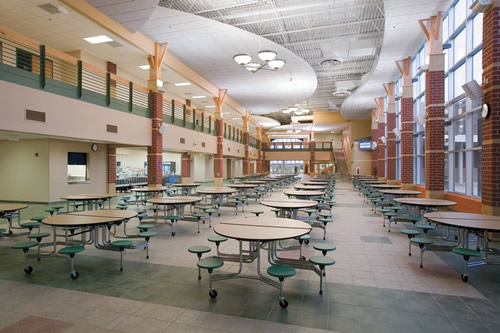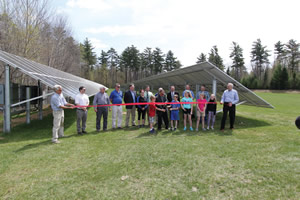Intelligent Schools
- By Michael Fickes
- 03/01/19

PHOTO COURTESY OF HOFFMAN PLANNING DESIGN & CONSTRUCTION, INC.
Can you define an intelligent building? The term has gained wider and wider recognition since the 1980s. It has meant smart heating, smart cooling, and both smart heating and cooling—first one, then the other, then both. Today, finally, despite nearly 40 years of varied meanings, the term “intelligent building” is beginning to achieve a fixed definition.
“At HID Global, we define intelligent buildings as buildings in which one can leverage the access control infrastructure to create more seamless and intuitive user experiences,” says Ashish Malpani, director of Product Marketing with HID’s Department of Extended Access Technologies.
But that is what comes next, says Malpani. “Today intelligent buildings are mostly focused on energy and energy savings,” he continues. “These goals are achieved by optimizing building systems so that they use more and less energy depending on the needs of current building occupants.”
Sensors placed throughout a building tell the lighting and HVAC systems where people are in the building, and the systems respond with lighting and heating or cooling as needed to adjust the lighting and temperature to optimal levels.
The Environmental Protection Agency (EPA) has its own definition of intelligent buildings. According to the EPA media office, “Commercial buildings operate as dynamic systems, writes an EPA representative in response to written questions submitted to the agency. “We know that the greatest gains in energy efficiency come when teams take a whole-building approach, rather than tackling individual upgrades and projects in isolation.
“For example, replacing old lighting with more efficient—and less heat-producing—LEDs will not only save on lighting costs, but will also lower a building’s summer cooling needs, which could lead to a smaller, less energy-intensive cooling system.
WHAT ARE THE BENEFITS OF AN EPA-STYLE INTELLIGENT BUILDING?
“Assuming an intelligent building operates as intended, the energy savings can be substantial,” says the EPA. “ENERGY STAR certified buildings (those that perform better than 75 percent of similar buildings nationwide) typically use 35 percent less energy than typical buildings. For K-12 schools, these cost savings are often redirected to support the central mission—namely teacher salaries, supplies, and programs.”
At the next rendering of building intelligence, which is being developed now, a smart building will literally deliver a personalized experience for employees as well as visitors, continues Malpani.
WHAT DOES IT MEAN TO DELIVER A PERSONALIZED EXPERIENCE?
“It means that as a visitor, I don’t want to wait to get through the front door, then wait for a badge, then wait for the elevator,” explains Malpani. “Waiting at all of these friction points drives down productivity.

PHOTO COURTESY OF HOFFMAN PLANNING DESIGN & CONSTRUCTION, INC.
“As an employee, I don’t want to wait for my coffee or the heat or air-conditioning to adjust the temperature in my office. As buildings grow smarter, they will deliver more and more optimized personalized experiences. We’re not there yet but this is the goal.”
Malpani’s vision of the coming generation of smart buildings describes structures nothing short of amazing—and the coming generation of amazing intelligence includes school buildings. “If you’re in school today, you probably have a badge, which may or may not have some intelligent functions.
“The next step, however, will be to add RFID technology (Radio Frequency Identification) to the card. Then, the student can use the card like a credit or debit card for purchases, to check out library books, and access digital content on the computer both in schools and at home.
“When we establish identities, the technology integrates identities into various activities such as library borrowing, as well as checking out sports equipment, musical equipment artists supplies, and so on.”
In short, whatever we use a card for today will be a likely application for the rising generation of smart access cards.
Back to the building. What does it mean for an intelligent building to deliver a personalized experience?
“For example, every morning at 10 a.m., I make a cup of coffee and drink it. In an intelligent building environment, when my desk senses that I am getting up from my chair around 10 a.m., it can be programmed to alert the coffeemaker.
These examples illustrate a couple of things an intelligent building can be programmed to do today. What about an intelligent K-12 school building? What can intelligence bring to school?
SMART SCHOOLS TODAY
“When an architect adds optimized intelligence to a school building today, he or she focuses on four features,” says Mark Hanson, director of Sustainable Services with Appleton, Wisc.-based Hoffman Planning, Design & Construction, Inc.

PHOTO COURTESY OF HOFFMAN PLANNING DESIGN & CONSTRUCTION, INC.
First, the architect will add modern conveniences and economies to the overall structure. For example, these might include insulated windows and solar power.
Second, continues Hanson, a designer will work on integrating the building systems, including the mechanical, electrical, plumbing, water, and security systems. Appropriate controls, such as integration, enable a maintenance technician to monitor and evaluate building performance and utility trends. Armed with that knowledge, a technician can make adjustments by tapping into the building automation system (BAS) on-site or from a remote location.
Third, according to the EPA, a connected building can provide people services better than a conventional building. Such a building can sense what spaces in the building are occupied, by one person or a group, and what the occupants might need to be comfortable. Of course, if the building makes a poor decision, occupants can override the controls and control their area’s environment themselves.
Fourth comes the task of improving building management. “The building needs to be connected to the Internet,” Hanson says. “The building also needs sensors that keep track of the people in the building: How many people are in the building? Where are they in the building?
“When a properly programmed building senses occupancy, its building automation system will reduce the window shading to allow for daylighting. If the daylight available at the time proves insufficient, the building will turn on the lights in that part of the building.

PHOTO COURTESY OF HOFFMAN PLANNING DESIGN & CONSTRUCTION, INC.
Intelligent integration. Intelligent buildings have gotten a lot smarter in the past 40 years. Once only a term that related to HVAC controls, it has grown to include features that save energy across the board. According to the United States Environmental Protection Agency (EPA), the greatest gains in energy efficiency come when teams take a whole-building approach, rather than tackling individual upgrades and projects in isolation. This type of approach should include elements like mechanical, electrical, plumbing, water, and security systems.
According to the EPA, designers should check out an EPA tool called the “Target Finder Calculator.” The calculator scores an intelligent design and offers a qualified opinion as to whether the design’s predicted energy use measures up to real K-12 schools operating across the country. “A score of 75 or higher means that, once built, the school should be more energy efficient than 75 percent of similar schools across the country,” says the EPA in a written statement. “In these cases, firms’ designs may be recognized as ‘Designed to Earn the ENERGY STAR’ by the U.S. EPA. More than 230 K-12 Schools have earned this distinction since 2004.”
The EPA statement goes on to note that if “an intelligent building operates as intended, the savings can be substantial. ENERGY STAR certified buildings (those that perform better than 75 percent of similar buildings nationwide) typically use 35 percent less energy than typical buildings. For K-12 schools, these cost savings are often redirected to support the central mission—namely teacher salaries, supplies, and programs.”
What are your district’s annual electricity costs? What could you do with a savings of 35 percent?
LIGHTING UP TOMORROW FOR EVEN LESS
In “Intelligent Buildings,” an article by Mark Hanson and Jody Andres, AIA LEEDAP, also of Hoffman Planning, Design & Construction, Inc., the authors suggest that technological advances being developed now may cut utility costs even further.
For example, many utilities are currently developing smart grids capable of providing real-time price information—utility prices tend to move up and down throughout a 24-hour day. “When power costs are elevated, such as at peak demand times,” write Hanson and Andres, “nonessential equipment or some lighting can be programmed to turn themselves down or even turn off.
“Demand rises and peaks at certain times throughout every day,” Hanson says. “Prices rise and fall as demand rises and falls. Programming can tell the building controls to implement short term measures when demand and pricing peak.”
For instance, continues Hanson, a building’s automation system might be programmed to prevent the chiller from operating above 70 percent of its capacity. During peak demand periods, as the chiller approaches 70 percent of its capacity, a programmed HVAC system will reset temperatures so as to limit air conditioning or heating, lighting in certain areas of the building, and limit fan pressures in certain systems.
While the focus here has been on intelligent control a building’s HVAC system, there are other kinds of intelligent building controls. For example, CO2 sensors can be set to manage ventilation. When connected to an intelligent building’s controls, CO2 sensors can cause the automation system to adjust a building’s vents, increasing and decreasing the flow of outside air into the building as needed.
“We are heading for a world where prices are no longer fixed, but change in real time as demand changes,” Hanson says.
Intelligent building systems will literally discuss costs with the electric grid and perhaps other sources of building costs, and as prices rise and fall, the buildings will adjust their power consumption.
Intelligent buildings may not be smarter than your students. Still, buildings with such capabilities are very, very smart.
This article originally appeared in the School Planning & Management March 2019 issue of Spaces4Learning.